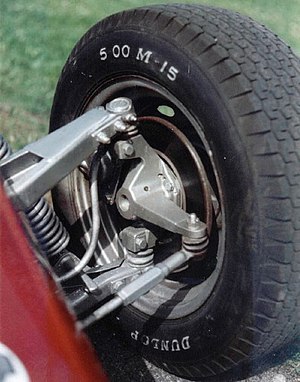Wishbone suspension
A double wishbone suspension is an automobile independent suspension design using two parallel wishbone-shaped arms to locate the wheel. Each wishbone (or arm) has two mounting positions to the chassis and one joint at the knuckle. The shock absorber and coil spring mount to the wishbones to control vertical movement. Double-wishbone designs allow the engineer to carefully control the motion of the wheel throughout suspension travel, controlling such parameters as camber angle, caster angle, toe pattern, roll center height, scrub radius, scuff and many more.
The double wishbone suspension is also often referred to as double 'A' arm or short long arm (SLA) suspension. It is commonly used in sports cars, luxury cars and light trucks.
A very similar arrangement, often using a single arm, is the A-arm suspension.
The suspension consists of a pair of upper and lower lateral arms, roughly horizontal and of similar length. The upper arm is usually slightly shorter to induce more negative camber on the outside wheel as the vehicle body rolls in a turn. Between the arms there is a knuckle with a spindle or hub which carries the wheel bearing and wheel. Knuckles with an integral spindle usually do not allow the wheel to be driven. A bolt on hub design is commonly used if the wheel is to be driven.
In order to resist fore-aft loads such as acceleration and braking, the arms need two bushings or ball joints at the body.
At the knuckle end, single ball joints can be used, in which case the steering loads have to be taken via a steering arm, and the wishbones look A or L shaped. An L shaped arm is generally preferred on passenger vehicles because it allows a better compromise of handling and comfort to be tuned in. The bushing in line with the wheel can be kept relatively stiff to effectively handle cornering loads while the offline joint can be softer to allow the wheel to recess under fore aft impact loads. For a rear suspension a pair of joints can be used at both ends of the arm, making them more H shaped in plan view.
In front view the suspension is a 4 bar link, and it is easy to work out the camber gain (see camber angle) etc, for a given set of bush locations.
The various bushes do not have to be on horizontal axes, parallel to the vehicle centre line. If they are set at an angle then antidive and antisquat can be dialled in.
The advantage of a double wishbone suspension is that it is fairly easy to work out the effect of moving each joint, so you can tune the kinematics of the suspension easily and optimize wheel motion. It is also easy to work out the loads that different parts will be subjected to which allows more optimized lightweight parts to be designed.
The disadvantage is that it is slightly more complex than other systems like a MacPherson strut.
SLAs are very common on front suspensions for larger cars, Pickups and SUV's and double wishbones are very common at both ends of racing cars.
Prior to the dominance of front wheel drive in the 1980s, many everyday cars used double-wishbone front suspension systems, or a variation on it. Since that time, the MacPherson strut has become almost ubiquitous, as it is simpler and cheaper to manufacture. Double-wishbones are usually considered to have superior dynamic characteristics, load handling capability and are still found on higher performance vehicles.
